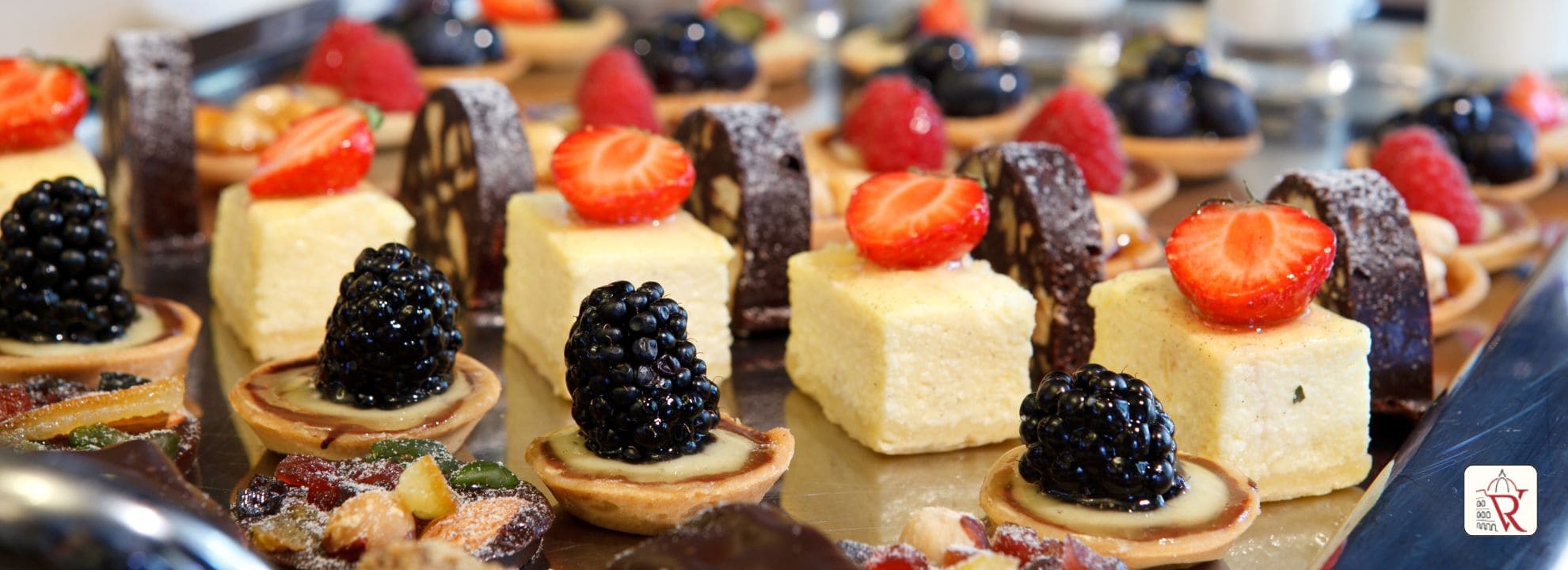Best desserts in Rome: top pastries, gelato and where to try them
- 9 min read
In this guide you will find all the information you need about the most iconic desserts in Rome, their fascinating history, and the best ways to enjoy them during your stay in the Eternal City. From creamy gelato and indulgent maritozzi to the ricotta and sour cherry tart, the beloved cornetto, crunchy tozzetti, and traditional holiday treats like pangiallo, mostaccioli, ciambelline al vino, and tiramisu, every sweet bite tells a story of Roman culture.


Omnia card 72h + Roma Pass - Jubilee 2025
The most famous dessert in Rome: Gelato
Gelato is not simply ice cream; instead, it represents centuries of Italian culinary refinement. The first version of gelato is said to date back to 1565, when Bernardo Buontalenti created a mixture of milk, honey, egg yolks, and wine for the Medici family. Since then, gelato has become one of the most popular desserts in Rome and continues to define Italian summers. Moreover, its smooth texture and natural flavors distinguish it from international variations.
How to enjoy gelato in Rome
When you look for gelato, do not only rely on presentation. On the contrary, avoid shops that pile gelato high and display unnaturally bright colors. Instead, choose gelaterie with flat metal tubs and muted tones, which usually indicate artisanal quality. Additionally, tasting seasonal fruit flavors is an excellent way to experience Rome’s authentic traditions.
Best moment to eat gelato: afternoon or evening, especially during summer strolls.
Where to eat gelato in Rome: Centro Storico, near Piazza Navona or the Pantheon.
The iconic dessert in Rome: Maritozzi
Maritozzi are soft brioche buns filled generously with whipped cream, and they are among the most iconic desserts in Rome. Historically, these pastries were linked to Lent, when a slightly less sweet version was consumed as a modest treat. As a matter of fact, the name maritozzo derives from the Italian word marito (husband), because men used to offer them as a token of affection to their fiancées.
How to enjoy maritozzi in Rome
To savor the real taste of maritozzi, visit traditional pastry shops rather than modern cafés. In particular, neighborhoods such as Trastevere offer bakeries where recipes have been preserved for generations. Moreover, pairing a maritozzo with a cappuccino in the morning is a classic Roman breakfast ritual.
Best moment to eat Maritozzi: breakfast or mid-morning snack.
Where to eat Maritozzi in Rome: Trastevere bakeries.
Traditional Roman dessert: Ricotta and sour cherry tart
The ricotta and sour cherry tart, or crostata di ricotta e visciole, is another must among desserts in Rome. This pie combines creamy ricotta with tangy sour cherries, all wrapped in a crisp shortcrust pastry. According to tradition, it originated in the Jewish Ghetto in the 18th century, when dairy consumption was restricted. Consequently, bakers cleverly hid ricotta inside a pastry crust, giving birth to one of Rome’s most symbolic sweets.
How to enjoy the tart in Rome
One cannot leave the Jewish Quarter without tasting this dessert at Pasticceria Boccione, a historic bakery serving Roman-Jewish delicacies since 1815. Furthermore, ordering a slice with an espresso is a perfect way to balance sweetness with strong Italian coffee.
Best moment to eat ricotta and sour cherry tart: after lunch or as a mid-afternoon dessert.
Where to eat ricotta and sour cherry tart in Rome: Jewish Ghetto, at Pasticceria Boccione.

Omnia card 72h + Roma Pass - Jubilee 2025
The typical Roman breakfast pastry: Cornetto
Italian cornetto, often compared to the French croissant, has a lighter, more buttery texture that makes it unique. Its origins are linked to the late 17th century, when a Viennese baker celebrated victory against the Ottomans with a crescent-shaped pastry. Eventually, this creation spread to Italy, where it became part of everyday life. Today, the cornetto remains an essential part of Roman mornings.
How to enjoy Cornetto in Rome
Romans usually begin the day with a cornetto and a cappuccino at the bar counter. For a true local experience, head to Mercato Testaccio. Moreover, trying different fillings—plain, cream, or jam—allows you to discover the variety of flavors hidden in this humble pastry.
Best moment to eat Cornetto: early morning with coffee.
Where to eat Cornetto in Rome: Mercato Testaccio or local bars in San Lorenzo.
The classic dessert in Rome: Tozzetti biscuits
Tozzetti (almond biscuits) are Rome’s answer to the famous Tuscan cantucci. However, these biscotti are less sweet and often flavored with lemon zest or anise seeds. Because they are baked twice, they achieve a long shelf life, which historically made them ideal for soldiers and travelers. Today, they remain one of the most traditional desserts in Rome, especially enjoyed after meals.
How to enjoy tozzetti in Rome
The best way to eat tozzetti is by dipping them in a glass of Vin Santo, a sweet Italian wine. In addition, many Roman wineries serve this pairing as part of their tasting menus, allowing visitors to appreciate the balance between crunchy almonds and rich wine.
Best moment to eat Tozzetti: after dinner with dessert wine.
Where to eat Tozzetti in Rome: wine bars in Monti district.
The festive Roman dessert: Pangiallo Romano
Pangiallo, literally meaning “yellow bread,” is a traditional Christmas dessert in Rome with origins dating back to the Roman Empire. Prepared with nuts, candied fruits, honey, and spices, it was originally offered during the winter solstice to bring good fortune. Although this dessert is mostly associated with the holiday season, it still represents a remarkable example of how desserts in Rome connect past traditions with present celebrations.
How to enjoy pangiallo in Rome
If you visit Rome during the winter months, head to historic bakeries in the city center, such as those near Campo de’ Fiori. Moreover, pairing pangiallo with a glass of dessert wine enhances its rich and fruity flavors.
Best moment to eat Pangallo: festive season afternoons or evenings.
Where to eat Pangallo in Rome: Campo de’ Fiori bakeries.

Omnia card 72h + Roma Pass - Jubilee 2025
The classic Roman biscuits: Mostaccioli
Mostaccioli are spiced cookies with very ancient roots. According to legend, they were already mentioned by the poet Virgil in his works. Traditionally prepared with flour, honey, almonds, and sometimes wine, these cookies are dense yet fragrant, making them a staple among old-fashioned desserts in Rome. Despite being less common today, they still appear during religious festivals and traditional markets.
How to enjoy mostaccioli in Rome
You can often find them in pastry shops during Christmas or Easter. Additionally, tasting them together with a hot espresso highlights their spiced, nutty aroma.
Best moment to eat Mostaccioli: during Christmas or Easter afternoons.
Where to eat Mostaccioli in Rome: Prati pastry shops.
The traditional dessert of Rome: Ciambelline al vino
Ciambelline al vino are the wine cookies of Lazio. These small ring-shaped cookies are a specialty of the Lazio region and are deeply connected with Roman rural tradition. Made from flour, olive oil, sugar, and wine, they are baked until crunchy. As a result, they perfectly embody the simplicity of local ingredients while still being among the most cherished desserts in Rome.
How to enjoy ciambelline al vino in Rome
The authentic way to eat them is by dipping them directly into a glass of red wine, usually from the Castelli Romani area. In fact, many traditional Roman trattorias still serve them at the end of a meal instead of other desserts.
Best moment to eat Ciambelline al vino: after dinner, dipped in wine.
Where to eat Ciambelline al vino in Rome: trattorias in Trastevere or Castelli Romani stalls.
The Italian dessert loved worldwide: Tiramisu
Although tiramisu originated in Veneto, it has become a must-try dessert in Rome as well. Layers of espresso-soaked ladyfingers, mascarpone cream, and cocoa powder make it one of the most beloved Italian sweets worldwide. Above all, tiramisu has conquered Roman pastry shops, where chefs often create their own versions with pistachio, strawberries, or Nutella. Consequently, it has joined the list of iconic desserts in Rome for visitors who cannot resist a classic indulgence.
How to enjoy tiramisu in Rome
For the best experience, order tiramisu in a traditional trattoria after a typical Roman dinner. Furthermore, trying creative variations in artisanal bakeries allows you to explore how Rome reinvents this national classic.
Best moment to eat Tiramisu: after dinner as a restaurant dessert.
Where to eat Tiramisu in Rome: traditional trattorias in the historic center.

Omnia card 72h + Roma Pass - Jubilee 2025
FAQ
What sweets to eat in Rome?
You should try gelato, maritozzi, ricotta and sour cherry tart, cornetti, and tozzetti, all iconic desserts in Rome.
What is a typical Roman sweet?
Maritozzi, soft buns filled with whipped cream, are among the most traditional Roman sweets.
What is the most popular sweet in Italy?
Gelato is arguably the most popular Italian sweet, enjoyed across the country and especially in Rome.
What pastry is Rome famous for?
Rome is particularly famous for maritozzi and cornetti, both integral to its culinary tradition.
What is the sweetest Italian dessert?
Tiramisu is often considered the sweetest, though many desserts in Rome such as crostata di ricotta also compete for the title.
What is Rome’s speciality food?
Rome is famous not only for pasta dishes but also for its desserts, including maritozzi and ricotta tart.
What are the best pastries in Italy?
Regional specialties include Neapolitan sfogliatella, Sicilian cannoli, and Roman maritozzi.
What is a croissant in Rome?
In Rome, the croissant-like pastry is called a cornetto, usually eaten for breakfast.
Is Rome known for tiramisu?
While tiramisu originated in Veneto, it is widely available in Rome’s restaurants and bakeries.
What is a classic Italian dessert?
Gelato and tiramisu are considered classic Italian desserts, enjoyed nationwide.
What is mascarpone?
Mascarpone is a creamy Italian cheese, commonly used in desserts like tiramisu.
What do Italians eat for breakfast?
A typical Italian breakfast includes a cornetto with coffee, often consumed quickly at the bar counter.

